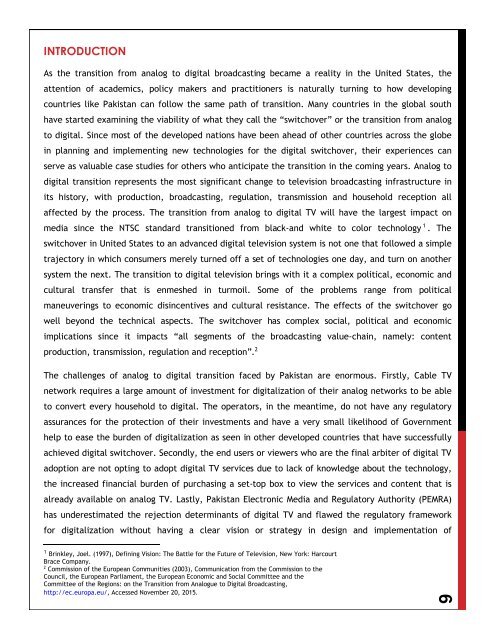DIGITAL SWITCHOVER IN PAKISTAN
Digital-Switchover-in-Pakistan-Report
Digital-Switchover-in-Pakistan-Report
You also want an ePaper? Increase the reach of your titles
YUMPU automatically turns print PDFs into web optimized ePapers that Google loves.
<strong>IN</strong>TRODUCTION<br />
As the transition from analog to digital broadcasting became a reality in the United States, the<br />
attention of academics, policy makers and practitioners is naturally turning to how developing<br />
countries like Pakistan can follow the same path of transition. Many countries in the global south<br />
have started examining the viability of what they call the “switchover” or the transition from analog<br />
to digital. Since most of the developed nations have been ahead of other countries across the globe<br />
in planning and implementing new technologies for the digital switchover, their experiences can<br />
serve as valuable case studies for others who anticipate the transition in the coming years. Analog to<br />
digital transition represents the most significant change to television broadcasting infrastructure in<br />
its history, with production, broadcasting, regulation, transmission and household reception all<br />
affected by the process. The transition from analog to digital TV will have the largest impact on<br />
media since the NTSC standard transitioned from black-and white to color technology 1 . The<br />
switchover in United States to an advanced digital television system is not one that followed a simple<br />
trajectory in which consumers merely turned off a set of technologies one day, and turn on another<br />
system the next. The transition to digital television brings with it a complex political, economic and<br />
cultural transfer that is enmeshed in turmoil. Some of the problems range from political<br />
maneuverings to economic disincentives and cultural resistance. The effects of the switchover go<br />
well beyond the technical aspects. The switchover has complex social, political and economic<br />
implications since it impacts “all segments of the broadcasting value-chain, namely: content<br />
production, transmission, regulation and reception”. 2<br />
The challenges of analog to digital transition faced by Pakistan are enormous. Firstly, Cable TV<br />
network requires a large amount of investment for digitalization of their analog networks to be able<br />
to convert every household to digital. The operators, in the meantime, do not have any regulatory<br />
assurances for the protection of their investments and have a very small likelihood of Government<br />
help to ease the burden of digitalization as seen in other developed countries that have successfully<br />
achieved digital switchover. Secondly, the end users or viewers who are the final arbiter of digital TV<br />
adoption are not opting to adopt digital TV services due to lack of knowledge about the technology,<br />
the increased financial burden of purchasing a set-top box to view the services and content that is<br />
already available on analog TV. Lastly, Pakistan Electronic Media and Regulatory Authority (PEMRA)<br />
has underestimated the rejection determinants of digital TV and flawed the regulatory framework<br />
for digitalization without having a clear vision or strategy in design and implementation of<br />
1 Brinkley, Joel. (1997), Defining Vision: The Battle for the Future of Television, New York: Harcourt<br />
Brace Company.<br />
2<br />
Commission of the European Communities (2003), Communication from the Commission to the<br />
Council, the European Parliament, the European Economic and Social Committee and the<br />
Committee of the Regions: on the Transition from Analogue to Digital Broadcasting,<br />
http://ec.europa.eu/, Accessed November 20, 2015.<br />
6


